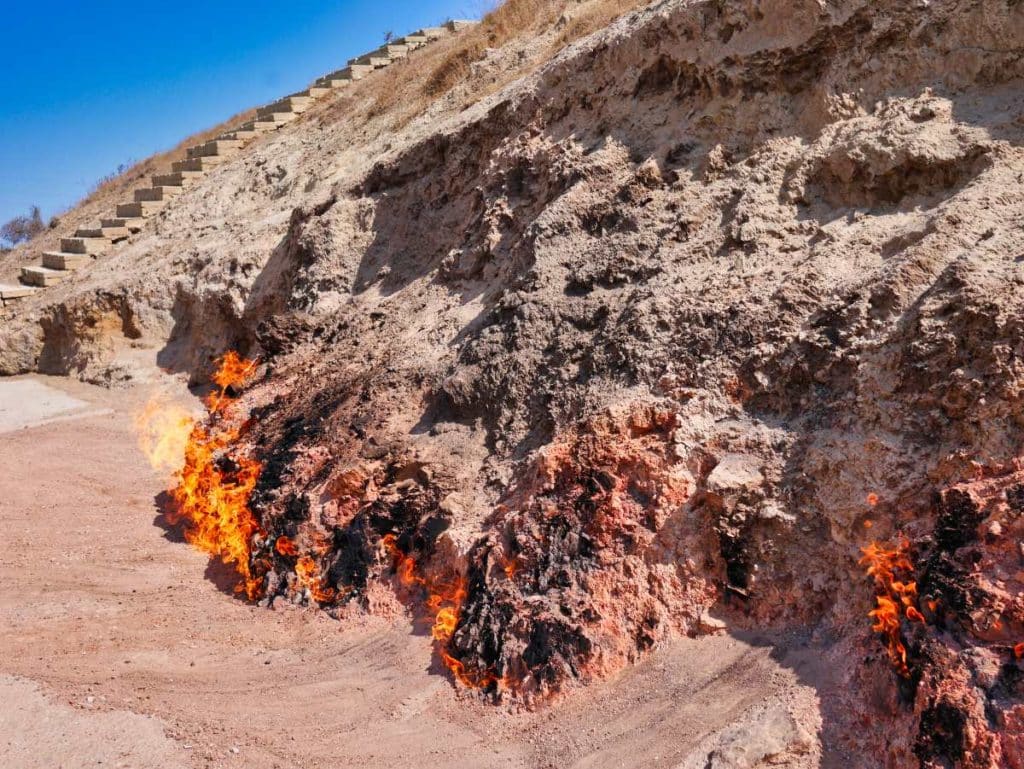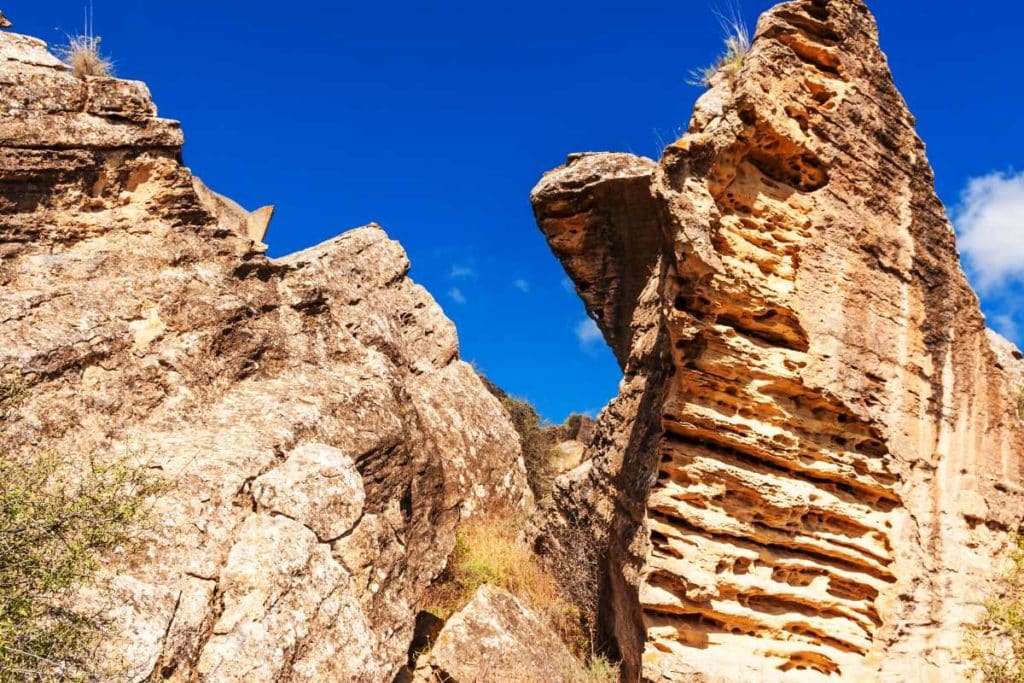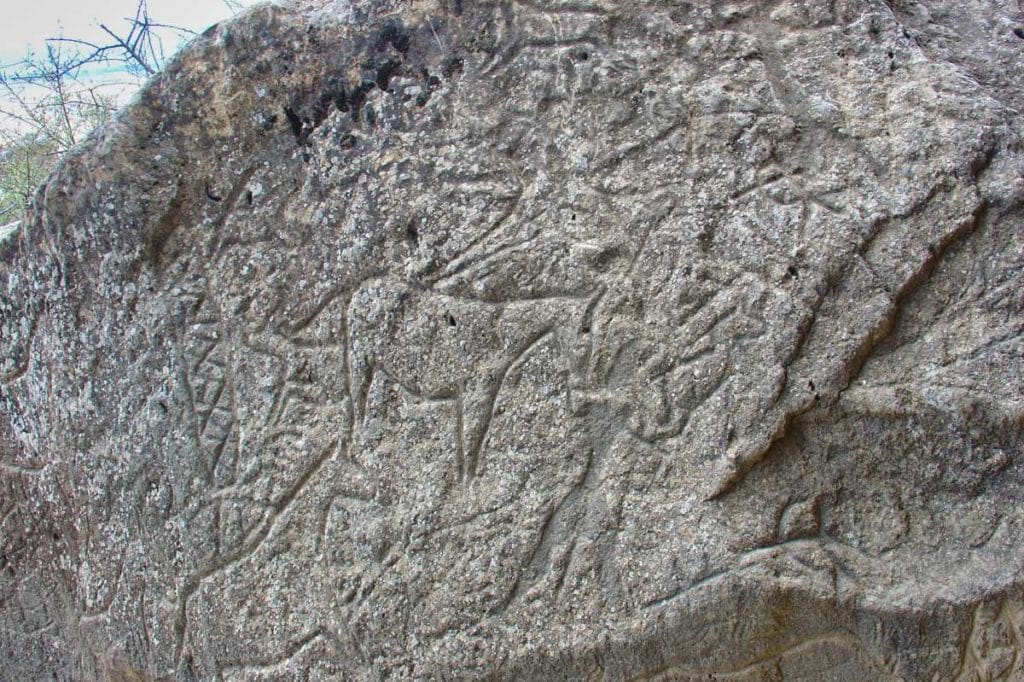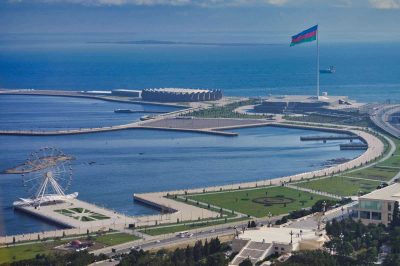Rock art stands at the beginning of human creativity in art history and have always exerted a special fascination. Gobustan National Park in Azerbaijan is located about 50 kilometers south of Baku and is considered by researchers to be one of the oldest settlements in the world. Stretching over 44 square kilometers, Gobustan National Park includes the Cinqirdağ plateau (236 m) as well as the Böyküdaş (201 m) and Kiçikdaş (117 m) mountains. The rock engravings were declared a UNESCO World Heritage Site in 2007 and are one of the absolute highlights of any trip to Azerbaijan. Reason enough to present you one of the TOP 10 sights in Azerbaijan in more detail.

Discovery in search of oil
This historically significant heritage was only discovered in the 1930s, when a road was to be built through the rock formation above the rising steppe in search of oil wells. Until then, no one had thought to penetrate this bizarre world of stones and mud volcanoes.

Mysterious works of art
Thousands of years ago, in the area with more than 300 mud volcanoes stretched a fertile savannah with abundant wildlife. At that time, the Caspian Sea had a water level about 25 meters higher and, accordingly, extended to the vicinity of these peculiar mountain formations. Before the Soviet invasion in the 1930s, shepherds lived in this area with their herds. The rock carvings, believed to be up to 11,000 years old, caught the eye of a quarry worker who was making his way through the massive boulders as part of a project to redevelop habitable land. As a result, blasting operations ordered from as far away as Moscow were stopped.
First examinations
The leading Azerbaijani archaeologist Isak Jafarzade was commissioned to take a closer look at the idiosyncratic drawings. In the course of the extensive investigations, which were to last until 1965, various types of petroglyphs were found on 750 rock outcrops. In the monograph published by Jafarzade in 1973, there is talk of 3500 petroglyphs. To date, 6000 signs have been listed and are open for viewing. It is striking that the engravings are between 1 and 30 millimeters deep. The fact that most of the petroglyphs are not on the rocks, but in the rock caves, indicates that the inhabitants sought shelter there.

A unique national heritage
In the museum, which belongs to the national park and is located two kilometers to the south, valuable finds such as pottery, arrowheads and the like are on display. More than 50,000 artefacts are stored in the museum’s storeroom, awaiting closer examination or interpretation. Of particular importance are the remains of breads (made of wheat and barley) from Asia. In the early publications about Qobustan there were no references to connections with similar line drawings from the settlement area of the Turkic peoples. In 1966, the Council of Ministers of the Azerbaijan SSR declared the monuments of Qobustan as the “historical-archaeological heritage of Azerbaijan”. It is believed that only 5% of the original petroglyphs have been preserved and the rest of the drawings have been weathered over the centuries.
In the monograph “Qobustan” written by the archaeologist Firuze Muradova and published in Baku in 1979, the reader comes across a large number of citations from relevant works, but only four reference works written by Western authors. All other sources are of Soviet origin.

Whales, lions and amazons
The drawings had been initially colored with natural colors, mainly ocher. Wild bulls, reindeer, snakes, lions, gazelles, wild boars and goats caught in traps and domesticated dogs used as hunting assistants can be seen. Fish and even whales may indicate the once higher sea level. There are also drawings of dancers and women. Hidden in a cavity on the rock, “the eight beauties” appear, eight female figures with narrow waists and wide hips. Their rich jewelry could refer to a divine lineage. Behind them, one sees arches that could have made them Amazons.

Trade with Scandinavia?
When in 1981 the Norwegian researcher Thor Heyerdahl was invited to Azerbaijan as a guest of the Academy of Sciences of the USSR, he visited Qobustan and wondered about a certain type of representations of reed boats, which had a sun symbol on the tip of the bow. He suspected a cultural exchange between Azerbaijan and Scandinavia based on these findings. He had found similar Neolithic drawings of boats in his native Norway. What supports his theory is the fact that in the remains of the former settlements of Qobustan shells were found, which demonstrably never occurred in the Caspian Sea. These shells can be seen in the museum of Qobustan.
Heyerdahl wrote:
“It is my conviction that Azerbaijan was an important center from which people went to all over the world and vice versa before times. The importance of Azerbaijan for the development of civilization is proved by the petroglyphs of Gobustan. One thing is certain: seafaring is older than civilization. Until now, the opposite was assumed. But this does not correspond to the truth. Because in contrast to this assumption we know today that in the beginning there were people who built seaworthy boats and only subsequently they got to know each other, could trade and learn from each other. This peaceful cooperation enabled the development of a unique form of life refined by technology and science – our civilization”.
In his last book “In Search of Odin” he came to the conclusion on the basis of evaluations that the history of the Vikings has left traces also in Azerbaijan. However, his theory was doubted by the scientific community.
The Romans in Azerbaijan?
The rock engravings of Qobustan are surrounded by all kinds of theories. The mystery of the petroglyphs has not been completely solved to this day. A strangely out-of-time, freshly restored and “signed stone”, which is said to have been inscribed by the legionaries of the Roman emperor Domitian, also raises questions. Domitian’s legion is said to have advanced to this region on the Caspian Sea around 80 AD. For unknown reasons, however, this stone was not carried up the mountain, but remained below. Supposedly, this inscription is the easternmost writing in Latin language, which was discovered until today.
The so-called “tambourine stone” (gaval daş) not far from the museum entrance produces sounds similar to those of a tambourine when struck with another stone. This is a miniature made especially for demonstration purposes, as the original tambourine stone is located in a rough terrain further up in the rocks.

The museum
The museum, which is part of the ensemble and well worth seeing, contains extensive information about the petroglyphs in Qobustan, but also about similar finds in other countries. In didactically well prepared exhibition rooms, the history of the petroglyphs can be experienced with the help of exhibits and text panels via touch screen.
- Museum Qobustan is open daily from 10 am to 6 pm.
- How to get there: From Baku metro station 28 May bus 195 goes to Qobustan, alternatively you can get there by cab for a few euros.
Book recommendations
You want to read more? Then we recommend the following two books about Azerbaijan.
- Johenning, Heike Maria (Author)
Everything you need to know about Azerbaijan’s troubled past, presented in a nutshell.
- Heike Maria Johenning (Author)
You want to know more about Azerbaijan’s culture? Than this book is the right choice!
- Holger Kretzschmar (Author)
Classical travel guide, that also covers Armenia and Georgia.
To prepare your trip, it is best to learn a few words in Azerbaijani. This book is great for beginners!
- Said, Kurban (Author)
You want learn how to cook Azerbaijani food? Than this is the right choice!
Portrait of Azerbaijan, presenting the country in all its facets.
How did you like our trip to Qobustan National Park? Let us know and write us a comment! And make sure to follow us on Facebook or Pinterest to stay updated about new articles.



